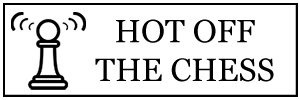
When one thinks back to round seven, the most disappointing aspect from a chess spectator’s point of view, was most likely the lack-lustre match between leaders Azerbaijan and Poland. If either of these teams had rolled up their sleeves and been prepared to get a little bloody, they could well have been rewarded with sole lead going into round eight.
Rather than taking the risk and going for it, however, they played rather safe and recorded a match of four steady, controlled, draws.
This being said, that decision was in itself not without a risk of its own. Namely, it gave the ambitious team of the United States of America, chance to catch up. And this they duly did by emerging victorious over Serbia.
Roll forward a day to this round and the United States are beating Azerbaijan 2.5-1.5. This was a very bloody match, seeing only one draw out of the four games. This was, namely, Hikaru Nakamura (2763) vs Arkadij Naiditsch (2721). The game was an English Bremen and looked quite spicy at a couple of points, but it didn’t look to me like either player was looking to score — shared spoils.
The excitement that this game lacked, the other games made up for in droves, however. The top board saw a much anticipated match up between Fabiano Caruana (2827) and Shakhriyar Mamedyarov (2820). This turned out to be an Open Ruy and, as Open Ruy’s can, it went deep into theory. It seems to have been Shakh who took the game into new territory, with his 24…Bf4. A few moves later, they arrived at the following position. (D)
Here, there is approximate equality and Shakh went for the continuation, 28…Bxd2 29.Rxd2 Rxd2 30.Qxd2 Rxe5. In hindsight, this may not have been the best decision. There were certainly credible alternatives, such as …Rd5 or …Bh6 if he was concerned about the Bf4.
The problem with the decision to go for exchanges, was that it helped White. The Nd2 that he gave the Bf4 for was not such a fabulous piece to be fair (well, not in my opinion anyway) and capturing on e5 deserted his back rank. This resulted in Caruana becoming rather active via 31.Qd8+ Re8 32.Qd5+ Qe6 33.Rd1. (D)
This position looks quite equal at first glance, but White is actually slightly better. Certainly in an endgame and this is shown if Black opts for the immediate 33…Qxd5. There would follow: 34.Rxd5 Re2 35.Rxc5 Rxb2 36.b4 g6. This leaves White the more active. He will play Rc7 to shut Black’s King out of the game and then activate his own via g2 and f3 etc. In the hands of a Grandmaster of Caruana’s ability, this is a very big plus.
And this is why Shakh could not go for it. It would condemn him to an inferior endgame in which White could play on until doomsday with a clear plan. He obviously had to find another way to proceed — but what? He chose 33…c4, which was just about as good as anything else. However, after the natural 34.bxc4 bxc4 35.Qb7, White still had the more positive stance.
For me, it is this that indicates that the decision to go down the 30…Rxe5 route, was ultimately flawed.
In saying this, however, Caruana still had to claim the point and Mamedyarov was certainly not just going to roll over. Also, we are talking about human chess, here, and that tends to involve oversights and inaccuracies. This game contained those from both sides.
In the end, Black’s King became the more vulnerable and with White being the more active, this was a deadly combination. Caruana commanded file and diagonal with his Queen and rook and drove Mamedyarov’s monarch out of its corner. Already losing, 59…Kg5(??) was a decisive mistake from Shakh, which saw his driven into a mating net: 60.f4+ Kh5 61.Rd2 Qg7 62.Rh2 Kg4 63.Kg2(!) g5 64.Qe8(! D)
Obviously, unable to prevent checkmate, Shakhriyar Mamedyarov resigned. This was a very big result for the United States and for Fabiano Caruana, who took his performance record in this tournament to +4 =3 -0.
Azerbaijan’s point-taker was Teimour Radjabov (2751), who rather comprehensively out-played Wesley So (2776) to win a pawn in their game. Not only did he have that extra pawn, but it was also a passer that stormed up the board. The single rook endgame saw the Black King unable to achieve enough activity to help with the defence and this was decisive. The diagram, below, shows So’s predicament and the American resigned here.
This game levelled the match and all eyes turned to Rauf Mamedov (2699) against Samuel Shankland (2722). What a game it was, their Giuoco Piano lasting almost 100 moves.
To be fair, Mamedov got absolutely nothing out of the opening as White. To me, his play seemed rather unambitious and this allowed Shankland to develop freely. Very soon, the American had equalised; and when he got in a quick …d5, he will have been rather satisfied. One thing that White did have going for him, was his dark-squared bishop, which sat nicely phalanxed on c3 as shown in the diagram, below.
It appears nice at first, anyway. The problem with this setup, is that White invested so much time in getting it, that Black just took control of the position around him. The Queenside pawn structure, ultimately proved to be a liability and just gave holes on b4 and d4 for Black to utilise.
And this he did, with 28…Nd4 coming next. Obviously, this hits the ‘stuck in the mud’ b3-pawn, but the point is more the Nf3. The other point, is that White is going nowhere fast, here. The only option for Mamedov after this move, if he wanted to go for any activity at all, would be Kingside play and that risks opening up his own king.
Ultimately, that is what he had to do (the alternative was to just sit and wait for Shankland), but first he exchanged off that dark-squared bishop, with 29.Bxd4. This is perhaps logical, Black’s knight is worth more that White’s bishop in this situation. However, that in itself is really an acknowledgement that things are not going well. And gradually, his position worsened to one in which Black had a complete stranglehold.
What followed was a very instructive conversion from Shankland, which saw him shuffle his King from its castled position on g8 to b7. (D)
In effect, this transposed the structure to one of opposite side castling. It is a very elaborate undertaking, (and it is debatable as to whether it was completely necessary or not), but Samuel wanted to be able to push on the Kingside without risk to his own King. Even with such a great stance, Black can not afford to ignore those white rooks. And it seems that he did have the time to relocate it, so why not? Also, in the endgame, the King would prove very useful on the Queenside, where White had the better concentration of pawns.
The game is well worth playing through and analysing, especially from this point, in order to appreciate the control that Black exercises over his opponent. In this, his King plays a very active role. Multiple area’s of operation, along with command of the fourth rank, helped Black towards achieving his goal — ultimately, a new Queen. A very nice finish (of 50-moves or so) from Shankland.
This secured the match for the United States of America. With Poland drawing against Armenia, the United States went to the top of the standings table. Poland will be their next opponents. Elsewhere, India beat Czech Republic 2.5-1.5, China beat Netherlands and France beat Ukraine by the same score. Russia beat Belarus 3-1.
Worthy of note is that Germany, England and Norway are also in the top ten and performing very well!
Top Standings after Round 8:
United States of America — 15
Poland — 14
Azerbaijan, India, France, China, Armenia, Germany, England, Norway — 13.
In the Women’s section, leaders after round seven, Armenia, found out that it is tough at the top. In this round, they hit a brick wall called Ukraine and came away a bit worse for wear. Two draws and then wins for Anna Muzychuk (2555) over Elina Danielian (2409) and Anna Ushenina (2451) over Anna M. Sargsyan (2331) made it a 3-1 victory, ultimately.
Danielian had a really bad opening against Muzychuk. Playing Black in a Winawer French, her 12…Nc6(?) was far too slow and landed her in hot water. White pawns began storming up the board and when this was coupled with poor development and a misplaced Queen, it was a tough ask to get back into the game.
And she didn’t, especially when Anna threw an advanced passed pawn into the mix. The game was a bit of a rout in the end, a final humungous blunder of 35…h6(??) leaving 36.Qe6+. The diagram, below, shows the final position, with Black to move out of check, leaving White to win the rook.
The new leaders are China, who only dropped a half point against Romania in their match. They face Kazakhstan in the next round in a match that Kazakhstan really need to win if they are to have serious hopes still. They have performed brilliantly in this Olympiad so far, but I think this pairing is probably beyond them.
This round also saw Russia whitewash Netherlands 4-0. And the wheels seemed to fall off of India’s bus a bit, as they ended up losing 3-1 to Hungary.
Top Standings (Women) after Round 8:
China, Ukraine — 14
United States of America, Hungary, Azerbaijan, Armenia, Kazakhstan — 13.
Round 9 is on Wednesday 3rd October, 15:00 local time. (check your time here.)

